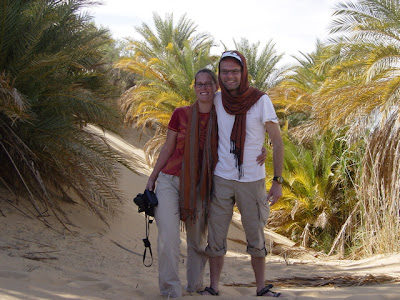A slow start after the late night makes a relaxing morning. We are set out to see the sights we missed the previous time in Aswan. We walked down the hill to the Nile boulevard to find a ferry to Qubbet Al Hawa. We are clearly back in a tourism hot spot as many people try to sell us things. Some things we would even be interested in buying if they were not so annoying and persistent. We ignored them and walked on. Jurriaan discovered he forgot his hat and scarf, and at 39 degrees with a burning sun, we were quick to buy a new one. The ferry brought us over to Qubbet al Hawa on the westbank for a few pounds. Here, there are tombs of nobleman (governors and other officials under the reign of Pepi II, who lived 2278-2184BC) hewn out of the cliffside.
Some of the tombs had nice reliefs and the whole setting was beautiful with the panoramic view on the Nile. Also build on this cliffside location, in between these graves, is and old Coptic church.
Elephantine Island’s Nilometers
Back at the bank of the Nile we negociated with a boatman to bring us to the Nilometers on Elephantine island. When we arrived on the island we brought a ticket for the museum and ruins of Abu, where the Nilometres are situated. We were so hot that we needed a drink. In the cool shadow of the museum, one of the guards offered to make us some tea. We offered him a nice baksheesh and everybody was happy. The museum actually had some nice artifacts and sarcophagi. We walked on to the Nile bank to check out the Nilometres. These were used for thousands of years to read of the level of the Nile and to announce to the rest of the country if a flood was coming. The Aswan dams have ended this. From the Elephantine Nile bank you a nice view on the Nile with is Fellucas passing by and the iconic Old cataract hotel on the other side.
Elephantine Island’s Ruins of Abu
The Nilometres are on an archeological site known as the ruins of Abu. There are several nicely restored temples here. The Satet Temple was build by Hatshepsut of the 18th dynasty and is dedicated to the goddess Satis. The temple of Khnum was build in the Old Kingdom and modified and used over 1500 years, before being substantially enlarged in Ptolemaic times.
The heat of the day made us drowsy and thirsty and close to the exit of the ruins site we found a nice Nubian café with cold cola’s and shade. The café was decorated with stuffed crocodiles, and as we discovered later, two living crocodiles in a large aquarium without water (poor buggers). Refreshed we walked to the ferry docks to go back to the hotel. On the way we saw a weaver weaving colourful shawls. While we were watching him, and thinking about buying one, the weaver offered us to have a go on his weaving device. We had a bit of fun trying, but it was more difficult than we thought. We bought a nice shawl and took the ferry back to the hotel.









